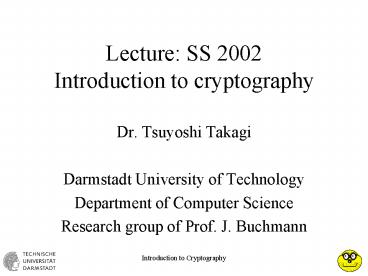Lecture: SS 2002 Introduction to cryptography - PowerPoint PPT Presentation
1 / 19
Title:
Lecture: SS 2002 Introduction to cryptography
Description:
Pretending. attacker. Introduction to Cryptography. Security Techniques. Encryption ... If the attacker knows the PIN, she/he can pretend to be the user. PIN (1205) ... – PowerPoint PPT presentation
Number of Views:28
Avg rating:3.0/5.0
Title: Lecture: SS 2002 Introduction to cryptography
1
Lecture SS 2002Introduction to cryptography
- Dr. Tsuyoshi Takagi
- Darmstadt University of Technology
- Department of Computer Science
- Research group of Prof. J. Buchmann
2
Lecture Plan
I will explain the content of the book J.
Buchmann, Introduction to cryptography,
Springer, 1998.
- Introduction
- Mathematic basics
- Encryption schemes
- Perfect secret
- DES or AES
- Public-key encryption
- Hash function
- Digital signatures
3
Attacks to an e-mail system
Company B
Company A
(1) Confidentiality. - Attacker can
eavesdrop the contract. (2) Authentication.
- Attacker can send a different contract to
company B. (3) Integrity. - Attacker can
modify the contract (100 Euro to 1000 Euro).
4
attacker
eavesdropping
Sender
Receiver
Pretending
Altering/Forgery
attacker
attacker
5
Security Techniques
- Encryption
- - Symmetric Cryptosystem (Secret-Key
Cryptosystem) - - Asymmetric Cryptosystem (Public-Key
Cryptosystem) - Signature
- - Symmetry (Message Authentication Code)
- - Asymmetry (Digital Signature)
6
Symmetric cryptosystem
d a common secret key between the user
and the bank Ed encryption function, Ed-1
decryption function, m Ed-1(Ed(m))
Receiver
Sender
m message
Encryption using d
Ed(m) cipher text
7
Public-key cryptosystem
(e public key , d secret key ) of
the receiver (Bank) Ee encryption function, Dd
decryption function, m Dd(Ee(m))
Receiver
Sender
m message
8
Advantage of PKC
- The number of secret keys is reduced
n is the number of users.
SKC
PKC
n
9
No common key is required
From Thomas.Koenig_at_ciw.uni-karlsruhe.de Newsgroup
s comp.security.unix,comp.security.misc,sci.crypt
,comp.answers,sci.ans wers,news.answers Subject
SSH (Secure Shell) FAQ - Frequently Asked
Questions Followup-To comp.security.unix,comp.sec
urity.misc Date Mon, 27 May 1996 112305
JST Organization University of Karlsruhe,
Germany -----BEGIN PGP
SIGNATURE----- Version 2.6.2i iQCVAwUBMZNu3PBuc
bJcKCVAQGrVgP/X7X6oMJrN9H8UYec1zjGTurJpU9nT/4x dBK
TYzeX7ZMUjEUlrmnWsw67aHDoO7XWkLYgH9lB8jVI24mSvgRX7
ow8Gqas7RGc 7E7LYgSwGZi6JttCv3r3TW8UCTkKAkEMpgAtE
eauVkDsr1hVb6B12EyGrq9JyW yulzNwYI3vU GUs ----
-END PGP SIGNATURE-----
10
Disadvantage of PKC
- The speed of encryption/decryption is slow
compared with symmetric cryptosystems - - The arithmetic of PKC is complicated.
- - A special coprocessor is required for the
implementation over smartcards.
11
Efficiency is important
For the sake of high security, a secret key is
stored on a smart card (tamper-resistant).
A special coprocessor is required for the
computation on a smart card, which is very
expensive.
Currently no public-key cryptosystems are used
for a large scale market, such as cash cards or
SIM cards for mobile phones
12
Examples of encryption schemes
- Symmetric cryptosystem
- - 3DES, IDEA, AES, etc.
- Asymmetric cryptosystem
- - RSA, Elliptic Curve Cryptosystem, etc.
13
Message Authentication Code
(d a common secret key ) of signer and
verifier Sd signing function, Vd verification
function, Vd(m) Sd(m)
Verifier
Signer
m message
m message
Signing using d
Verification using d
Sd(m) hash value
Vd (m)Sd(m)
14
Digital Signature
(e public key , d secret key ) of a
signer Sd signing function, Vs verification
function, m Vs(Sd(m))
15
Examples of Signature Schemes
- Message Authentication Code
- - hash functions MD5, SHA, etc.
- Digital Signature
- - RSA, DSA, Elliptic Curve Cryptosystem, etc.
16
Typical Usage
- A common secret key is shared by PKC.
- Data is encrypted by symmetric cryptosystem.
- Digital signature is used for integrity.
PKC
Data
Data
Symmetric cryptosystem
Digital Signature
17
Internet Banking (Web-Zugang)
Internet banking client
Internet banking server
PIN (1205)
PIN
PIN (1205)
- Confidentiality
- - Attacker can eavesdrop the PIN and data.
- (2) User Authentication
- - If the attacker knows the PIN, she/he
can pretend to be the user.
18
SSL (Secure Sockets Layer)
Which algorithms are used?
19
Secure E-Mail
Secure IP Network
PGP
Secure Payment
IPv6
Mobile Network
S/MIME
SET
i-mode
IPSEC
WAP
iKP
SSL
TSL
Secure Devices
Digital Signature
Public-Key Cryptosystem
NF
RSA
Lattice
Factoring
EC































